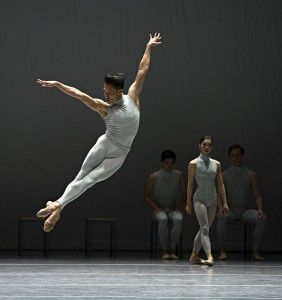The Boston Ballet’s Fall Program at the Boston Opera House, which opened Thursday Oct. 25, presents a blend of contemporary and classical dance styles in a way that manages to evoke nostalgia, yet in a new, exciting way.
The Fall Program starts out with the jaunty “Rooster.” Choreographed by Christopher Bruce in 1991 and set to music by The Rolling Stones, this performance melds ballet with jazz, contemporary and some go-go dancing to match era the music is set in. Adjusted ties become beaks, and steps across the stage turn to strutting as the male dancers channel the movements and characteristics of an actual rooster in the opening number.

The movements uphold the dreaminess and romance of a ballet. From partner work to the song “Lady Jane” to an energetic and fast paced duet set to “Not Fade Away,” all the dancers move with precision that gives the illusion of ease. The dance to “As the Tears Go By” goes through the stages of young love from yearning to elation to heartbreak. The audience stirred during opening night to the opening sitar notes of “Paint it Black,” and rightly so. The lead dancer fuses the emotional angst associated with the song, while a trio of female dancers added a certain gleeful element as classic 1960s go-go dancers in the background.
Where “Rooster” is fun and boisterous, the second act is thoughtful and reflective. Created by the renowned choreography Jorma Elo, “Awake Only” is meant to portray growing up and experiencing the many different emotions that come along. Appropriately, the curtain opens to show a very young boy standing in the middle of the stage. The whole dance then follows the loose story line of this little boy guiding his older self through life.
Everything about this piece is soft, from the Bach played by a piano and organ to the velvet pastel costumes and the refined classical ballet steps. An almost dreamlike mood is created as the principle dancers effortlessly move from one move to the next. The story becomes secondary to the captivating swift and beautiful movements. However, emotions such as love, confusion and discovery are not all lost. In fact, the lack of a completely linear story allows the audience members to focus more on what they feel in response to the dancers and less on what it is all supposed to mean.
The program ends with “The Second Detail” choreographed by William Forsythe, which features a heavy techno bass. The music escalates as more drums are added on top of each other. The dancers are all dressed in simple grey costumes against a stark grey background, which ties in with the hard and edgy movements as they move to keep in time with the underlying bass beat pulsating through the speakers. The movements seem like an orderly chaos as the dancers switch back and forth between sitting on chairs in the back and coming up front to do their numbers. There are no scene breaks, no running to the wings nor breaks in the song. Action and movement prevail as major themes in the piece, which manages to both excite and intrigue. When taken all together, the Fall Program is a success in that it is able dazzle the audience and still play to universal human emotions.
The individual parts that make the show noteworthy—the rooster movements, the partner work, the lifts—all come back in one exhibition full of liveliness. By the time the curtains fell opening night, that energy had been transferred to the audience’s loud applause.
Boston Ballet’s Fall Program runs through Sunday at the Boston Opera House.